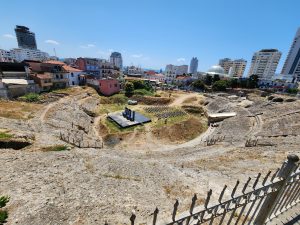
I’ve been to Durrës countless times. But this time, I chose to walk slowly — to notice, to observe, to connect.
My journey began at Currilat Beach, the beloved seaside spot for locals, and continued past the Sfinks — a massive staircase reminiscent of the Egyptian sphinx.
Not far from here stands the Fisherman Statue. With a fishing rod in hand and his gaze fixed on the horizon, he embodies the city’s eternal bond with the sea — silent yet strong, much like the people of Durrës.
From there, I reached the Vollga Promenade, once the heart of summer evening strolls. I paused at the Vollga Pier — a relatively new structure from the last two decades — a place I visit every time I’m in Durrës enjoy the wide-open view of the sea. The water stretches endlessly ahead, flanked on both sides by beaches, reminding me that this city lives and breathes with the tides.

My next stop was Marinari Square, a true ensemble of greenery, symbolism, and statues representing the city’s layered history — from ancient times to the present day — alongside motifs from underwater life such as shells and fish. One of the most unusual but striking elements here is the quartet of sculptures depicting music legends Tina Turner, John Lennon, Mick Jagger, and Bob Dylan. Though they have no direct link to Durrës, they enrich the city’s urban atmosphere and place it in symbolic dialogue with the world.
At the far end of the promenade rises the Veliera, a large concrete sail-shaped structure. Although its construction sparked debate, it has become part of the city’s urban identity, symbolizing Durrës’ deep-rooted connection to the sea.
The walk continued to the Venetian Tower — for two or three decades used rather ungraciously as a café, but now transformed into a 3D museum. Here, visitors can immerse themselves in the city’s history through VR experiences, exploring the Amphitheatre, the ancient Roman forum, and artworks from British painter Edward Lear, who visited the Balkans in the mid-1800s. The tower’s circular terrace offers a remarkable 360° vantage point over the entire coastal line — a reminder of its former role guarding the city walls.
 From there, I wandered along Epidamn Boulevard (named after the city’s ancient name), known for its elegant buildings on both sides. Recently revitalized under the project “Old Gates,” it’s home to the medieval hamam and leads toward one of Durrës’ crown jewels — the Roman Amphitheatre. Built in the 2nd century AD, it could hold up to 20,000 spectators, transporting you back to the spectacles of gladiators and the daily life of ancient citizens.
From there, I wandered along Epidamn Boulevard (named after the city’s ancient name), known for its elegant buildings on both sides. Recently revitalized under the project “Old Gates,” it’s home to the medieval hamam and leads toward one of Durrës’ crown jewels — the Roman Amphitheatre. Built in the 2nd century AD, it could hold up to 20,000 spectators, transporting you back to the spectacles of gladiators and the daily life of ancient citizens.
A short walk away lies the Great Mosque of Durrës, standing proudly in the central square, flanked by the City Hall and the theatre named after Alexander Moissi, the famous Austrian stage actor born here in the late 19th century.
Another important stop is the Roman Forum, modest in size yet rich in significance, quietly telling its story amidst buildings constructed over decades.
Although I couldn’t visit it this time, Durrës is also home to the Peeping Tourist Museum, a small but fascinating exhibition set in a preserved mid-20th-century home. It offers an intimate glimpse into life under communist Albania, when tourism was tightly controlled and even foreign visitors were discreetly monitored. Through period furnishings, personal stories, and symbolic details, the museum reveals how everyday life and state surveillance intertwined — adding yet another layer to the city’s complex history.
And finally, as the cherry on top, a visit to the Vila e MbretitZog, which I explored for the first time to complete my journey. Perched on the city’s most prominent hill, it commands sweeping views over the entire bay of Durrës. Even though damaged, with no doors or windows, its architecture retains an undeniable elegance and grandeur — still worthy of a royal residence.
Durrës is, in every sense, a city of layers of time — where every corner holds a story, and every walk is an invitation to rediscover it all over again.






